La sœur timide
LES ÎLES CAÏMANS SONT COMPOSÉES DE TROIS ÎLES — two of which divers know quite well. Grand Cayman’s reputation is built on fun in the sun, the vast Seven Mile Beach, cruise ships, snorkel excursions to Stingray City, and diving. Little Cayman is much smaller, but travelers revere it for its quiet, laid-back ambiance and the stellar dive opportunities along the iconic Bloody Bay Wall and Jackson’s Bight.
Cayman Brac, however, is not as well-known among dive aficionados despite the island’s infrastructure and attractions above and below the waterline. The big airstrip at Charles Kirkconnell International Airport accommodates large jets and offers multiple options for daily air service. A great dive resort and several smaller guest properties offer coordinated dive services on this 12-mile-long, 1-mile-wide island. Planes, boats, rooms, restaurants, tanks, compressors, and the clear, blue Caribbean Sea — what more could you want in a tropical dive destination?
During a recent visit, I was reminded of how good it is there. Cayman Brac was part of my first overseas assignment for a dive magazine. The resort I stayed at then is no longer there, but on this trip we boarded the boats at the same government pier and went to many of the same dive sites I had experienced 40 years ago. In the decade after my first trip, I continued to dive Cayman Brac at least once a year as the photo pro for the Nikonos Shootout events. Each summer several hundred divers gathered there for a Nikon-sponsored photo contest and a week on location to celebrate underwater photography. My daughter’s first Caribbean dive destination was Cayman Brac, although she was only three months old and probably doesn’t remember it as well as I do.
There was an element of déjà vu during this recent trip, although it was also quite different in many ways. Arriving at the airport and schlepping my bags was familiar, but the cab driver at the airport was especially excited to see me. I first thought his demeanor was the typical friendliness of the people there, but I soon learned I was the first international visitor in nearly two years. With travel restrictions largely gone and the cash flow ramping up again, he was happy.

L'épave du M/V Capitaine Keith Tibbets est en grande partie effondrée
au milieu du navire, mais la proue et la poupe sont pratiquement intactes.
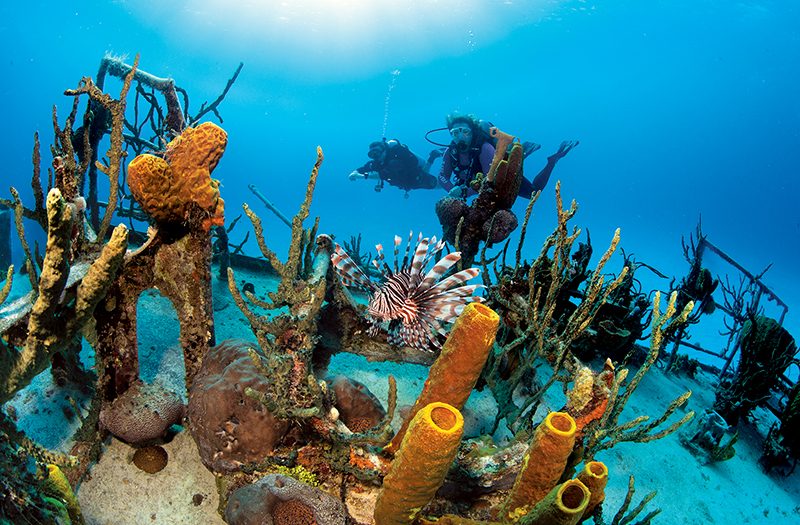
Poisson-lion et plongeurs à l'arrière du bateau Tibbets épave
While good diving is likely available all around the island, Cayman Brac’s topography dictates where most of the diving happens. The airport is on the island’s flatter western end, and the guest accommodations and dive services are close to the airport. To the east rises a dramatic bluff that’s inhospitable for docks and is a long boat ride from the west. The western tip is closer to Little Cayman than Cayman Brac’s North East Point 12 miles away. Occasional bluff-run boat dives happen in favorable conditions, but the majority of the moored dive sites are along the northwest side of the island in the lee of the prevailing winds. The southwest side also has several quality dive sites, although they are a bit more weather dependent. A one-week dive holiday that combines diving north- and south-side sites, a bluff run, and a half-day, three-tank trip to nearby Little Cayman will provide extraordinary diversity. Perhaps the Brac’s greatest charm is the variety of dives available there.
Mon dernier voyage a commencé par une plongée au La vallée de Grunt pour répondre à mon désir de photographier des bancs de poissons. Des bancs de chevesnes des Bermudes se sont mêlés à diverses espèces de grunts et de vivaneaux maîtres le long des têtes coralliennes de haut profil entre 25 et 35 pieds. Il y avait curieusement une forte densité de homards cette fois-ci, et bien que le récif ait semblé sensiblement le même que lors de ma dernière plongée ici en 2012, les vivaneaux et les grunts étaient nettement plus craintifs. Deux années avec moins de plongeurs ont peut-être eu un effet, mais il ne fait aucun doute qu'ils se réacclimateront rapidement à la présence des plongeurs et qu'ils poursuivront leurs activités de la même manière imperturbable que dans mon souvenir. Ce site est idéal pour une plongée d'échauffement.
La deuxième plongée (les plongées du matin sont généralement des plongées à deux bouteilles) a été effectuée dans le site au nom peu évocateur de Patch Reef. Avec 70 sites de plongée amarrés, je suppose que l'on manque d'inspiration pour les nommer. Ce qui manque à ce site en termes d'appellation est compensé par la décoration. La structure du fond dans les eaux peu profondes était riche en éponges tubulaires jaunes et en coraux durs, les éponges poussant parfois sur le corail cérébral.
Despite the colorful sponges and filter feeders decorating the seafloor, which would generally suggest the presence of currents, none of my dives had any perceptible current. The dive operators are cognizant of tides and local conditions, and they pick sites that aren’t particularly challenging. Unlike the Gulf Stream currents in the Florida Keys or the flow typical off Cozumel, dives here are generally mellow. The conditions are ideal for beginning divers or underwater photographers who prefer to stay in one place to set up a shot — anyone who will benefit from not having to work particularly hard to stay put.
Notre groupe étant restreint, nous avons fait un troisième plongeon vers l'un de leurs nouveaux sites d'amarrage, Allée des tortues. While the reef at the mooring pin’s base was much like the others (no surprise given their proximity), the mid-reef in 45 to 55 feet of water was rich with barrel and row pore rope sponges as well as the gorgonians typical of deeper reefs with a bit of current flow.
Despite the colorful sponges and filter feeders decorating the seafloor, which would generally suggest the presence of currents, none of my dives had any perceptible current. The dive operators are cognizant of tides and local conditions, and they pick sites that aren’t particularly challenging. Unlike the Gulf Stream currents in the Florida Keys or the flow typical off Cozumel, dives here are generally mellow. The conditions are ideal for beginning divers or underwater photographers who prefer to stay in one place to set up a shot — anyone who will benefit from not having to work particularly hard to stay put.
L'épave du M/V Capitaine Keith Tibbets is a highlight of any Cayman Brac dive expedition. In the 1999 dive guide I published with Bill Harrigan, the photos show a ship upright in the sand, perched on the edge of Cayman Brac’s north wall. At that time it was referred to as the “Russian Destroyer” or simply the “356.” In Shipwrecks of the Cayman Islands (épaves des îles Caïmans), Lawson Wood raconte en détail l'histoire de son naufrage au large de l'île. Le capitaine Wayne Hasson, de la flotte Aggressor, était en cale sèche pour la construction du navire. Cayman Aggressor en 1996, lorsqu'il l'a repéré sur un quai d'une base de la marine cubaine. Il mesurait 330 pieds de long, avec une poutre de 43 pieds et une coque en acier, et avait été construit avec une superstructure en aluminium pour gagner du poids.
Hasson learned it was to be scrapped for parts and had the epiphany that it would make a terrific artificial reef, so he reached out to the Cayman Ministry of Tourism and Transport, which shared his enthusiasm for creating a new dive attraction for Cayman Brac. After purchase from the Russian embassy, a tow from Cuba to the Brac, and a thorough cleaning, the ship was anchored and sunk on Sept. 17, 1996 — the result of countless volunteer hours but a relatively low $300,000 expenditure.
Un quart de siècle au fond de l'eau a fait des ravages. Tibbets. Il n'est plus debout et repose maintenant sur son côté bâbord le long de la pente de sable. Une grande partie de sa superstructure s'est effondrée. Je suis descendu à environ 85 pieds pour commencer la plongée en photographiant un grand groupe d'éponges tubulaires sur les rambardes de la proue. La plupart des plongeurs nagent probablement vers la proue et remontent progressivement le long des ponts en passant devant des garde-corps décorés de couleurs vives. Ils font une pause à l'emplacement des canons avant, passent devant le champ de débris qui se trouve maintenant au milieu du navire et terminent leur plongée au niveau des canons arrière et du pont, qui sont moins profonds.
It’s nice to have ample time on the stern deck, as it is one of the most photographically productive parts of the wreck. The sponge density along the rear railings is quite impressive, and the guns are awesome for a wide-angle setup with models. The money they spent to keep the guns on the wreck was a great deal, for they truly define and distinguish this wreck from so many others.
On this day I had a nice pass from a hawksbill turtle at the stern and a wonderfully photogenic lionfish nestled in the sponges cloaking the railings. Nonendemic lionfish are ubiquitous and can be part of the reef detail for dive journalists. Once the local dive operators begin to more regularly dive their sites and lionfish culling starts anew, lionfish populations may dwindle; but without significant dive activity here for two years, I expected the reefs to have a lot more lionfish than I saw. I didn’t find one on every dive, and I didn’t see more than one or two on any dive. This is not an empirical fish census, just a casual observation that it was counterintuitive to see so few lionfish on the reefs this time.
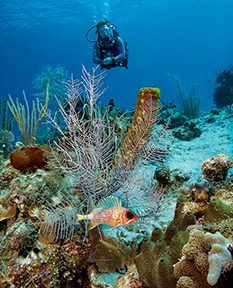
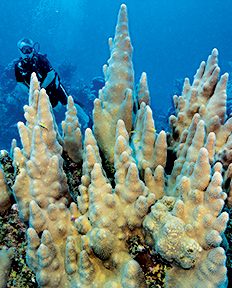
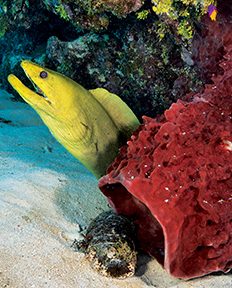
Je me fais toujours un devoir de visiter les trois fantastiques plongées de la paroi nord : Chute Est, Chute Moyenne, , et l' Chute Ouest. L'East Chute était autrefois très appréciée en raison de la présence d'un petit remorqueur. Marin des Caïmans sitting in the sand at about 55 feet, which was a nice place to offgas at the end of the dive. The past few passing storms have pretty well pancaked that wreck, so we opted for West Chute, mostly to see something new. I’m glad we did, because it was an outstanding dive. I had been asking for a chance to shoot some pillar coral because of the threat from the stony coral tissue loss disease that is raging through so many Caribbean island reefs, and I wondered how they fared on the Brac. There was no sign of coral disease on these deep coral buttresses in the 70- to 80-foot range, and I saw one fascinating pillar coral that was pristine except for an adjacent barrel sponge beginning to overtake it. Other pillar corals at Fin de l'île , et l' Récif de l'ange looked healthy. I’m not a coral scientist, but I think these reefs on the whole are doing quite well.
En dehors du corail pilier, qui aurait été une justification suffisante pour la plongée, nous avons trouvé une tortue imbriquée douce qui grignotait une éponge baril. Elle a toléré plusieurs photos et a ensuite nagé tranquillement le long de la face arrière de la bommie corallienne. Nous avons échangé quelques high five en signe d'exaltation pour une série de photos aussi productives, puis nous sommes remontés sur le bateau pour notre prochaine plongée à Maison dans les arbres à Stake Bay.
J'ai rappelé au personnel de plongée qu'une murène verte particulièrement agressive était venue à ma rencontre la dernière fois que je suis venu ici, il y a dix ans. Ils ont reconnu qu'il fut un temps où les murènes vertes étaient un peu fringantes, s'attendant à être nourries de poissons-lions après l'abattage et associant ainsi les plongeurs à un repas gratuit. Ils ont rapidement décidé de modifier leurs protocoles d'élimination des carcasses de poissons-lions, mais le renforcement intermittent est un comportement difficile à éliminer. Les murènes vertes de Treehouse sont toujours susceptibles d'être trouvées en train de nager librement, mais elles ne sont plus aussi pleines d'espoir ces jours-ci. Il y avait aussi un joli requin nourrice sous une corniche, mais c'était destiné à être notre journée tortues. Nous avons trouvé une autre tortue imbriquée dans les bas-fonds, semblant poser contre n'importe quelle éponge tubulaire jaune ou éventail de mer violet qu'elle pouvait trouver pour créer un arrière-plan magnifique.
Ma compagne de plongée, Barbara McDowall, est une vétérane de la plongée à Brac. Chaque fois que j'ai demandé à voir une vie marine ou une structure corallienne familière d'autrefois, elle a pu me suggérer les récifs les mieux reproduits. Elle m'a suggéré les récifs du sud-ouest, situés à quelques encablures du centre de plongée, pour ma recherche de coraux elkhorn et pillar.
Je me souviens des premiers jours où j'ai photographié des diapositives Velvia de forêts de cornes massives qui dominaient le récif frangeant et peu profond du côté sud. Bien qu'une grande partie de ces élodées ne soit plus qu'un vestige squelettique, il existe des peuplements intermittents d'élodées impressionnants. Sergent-major Reef, en particulier, présente des élkhorns isolés mais intacts, mêlés à des cascades de coraux étoilés. Ce n'est qu'après avoir plongé dans de nombreux endroits où ces coraux ont disparu que l'on se rend compte à quel point les endroits où ils subsistent sont spéciaux.
En accord avec le thème rétro de la semaine, notre dernière plongée consistait à Récif de l'ange. Cette fois, mon compagnon de plongée était Jason Belport, qui avait commencé sa longue et brillante carrière dans les opérations de plongée en tant que divemaster à Cayman Brac et qui a conservé une connaissance intime de ces récifs. Lorsque je lui ai dit que j'étais toujours à la recherche de corail pilier, il m'a infailliblement dirigé vers un spécimen particulièrement impressionnant. Une fois la photo prise, nous nous sommes embarqués pour nager autour des coraux dans la zone des 40 à 50 pieds. J'ai été ravi de voir un mérou de Nassau se diriger vers moi, freiner des quatre fers et me fixer avec impatience.
I hadn’t seen any groupers all week, which Barbara predicted would be the case because we were just off the full moon in February. The Cayman Brac grouper population had moved to Little Cayman for the annual grouper spawn known as “grouper moon.” By the end of my trip, however, several groupers had made it back to Brac reefs and were now making puppy goo-goo eyes at me — a behavior generally associated with food more than friendship.
J'ai répondu en les prenant en photo, bien sûr, mais s'ils s'attendaient à une aumône de ma part, ils auraient été déçus. J'ai pensé aux journées de nourrissage des poissons aux Caïmans, en particulier au mérou Goliath connu sous le nom de Sweetlips, qui se tenait sur les plages de l'île. Oro Verde naufrage et a fait la couverture de Plongeur en peau magazine back in the day. Sweetlips dined on a diet of frozen squid and Cheez Whiz for a few years until she wasn’t there anymore. Local divers speculated she might have eaten one too many Ziploc baggies from careless tourists, and her demise might have been one of the motivators for the Cayman Islands Department of Environment’s edict against fish feeding.
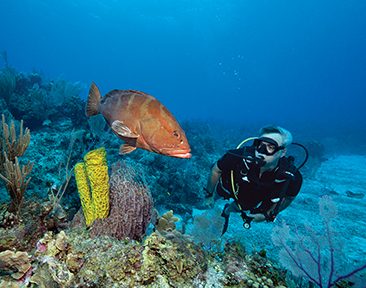
Mérou de Nassau et
plongeur à Angel Reef
These groupers were a legacy of classical conditioning, but not from fish feeding, for that was never a thing on Cayman Brac. In the early days of lionfish culling, however, the groupers, like the green morays over in Stake Bay, came to associate divers with a free meal. It seems the larger groupers are unlikely to take a live lionfish, but they would opportunistically scoop up one that had been speared and discarded on the seafloor. That doesn’t happen anymore, and presumably the groupers will extinguish that behavior one day.
For now, it was the highlight of my dive to have such friendly Nassau groupers hover within inches of my dome port, whatever their motivation might have been. I told myself that somehow they knew I don’t eat fish and wanted to reward me with proximity. AD
Comment y plonger
Pour s'y rendre : Plusieurs compagnies aériennes proposent des vols à destination de l'aéroport international Owen Roberts de Grand Cayman pour des vols de correspondance vers Cayman Brac. Un vol de 40 minutes permet de rejoindre Cayman Brac et Little Cayman. Le samedi, Cayman Airways propose un vol sans escale de 90 minutes à destination de Cayman Brac au départ de Miami. Il est encore plus facile de se rendre à Grand Cayman depuis que l'aéroport a été rénové et que des vols sans escale partent d'Atlanta (Delta) ; de Charlotte, Chicago, Dallas/Fort Worth, Miami ou Philadelphie (American) ; de Newark, Washington, D.C., Houston ou Chicago (United) ; de Fort Lauderdale ou Baltimore (Southwest) ; de New York, Boston ou Fort Lauderdale (Jet Blue) ; ou de Toronto (Air Canada ou West Jet).
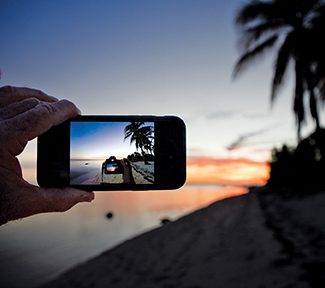
Conditions : The water temperature is usually 80°F to 85°F year-round, so a 3 mm wetsuit is perfect. Air temperatures are 74°F to 91°F. Visibility on Cayman Brac varies from good to outstanding — 60 feet to more than 100 feet unless there is a strong, consistent wind. When the north wind picks up, the waves can batter the beach and ironshore and stir the sediment on the shallow hardpan seafloor. The good news is that this leaves the southern dive sites with good visibility. The opposite is true with a southern or southeastern wind. It takes a heavy tropical disturbance to lose dive days on the Brac, but it can happen. The elevation is higher than Little Cayman, so Cayman Brac has weathered most hurricanes reasonably well. Still, events such as Hurricane Paloma can do massive damage.
Dive operators prefer that recreational divers keep to 100 feet and shallower. Currents aren’t often an issue, and most diving is in reasonably calm conditions. The dive operations are professional and safe, and most operate large and seaworthy boats. A hyperbaric chamber is in George Town, Grand Cayman.
En savoir plus
See more of Cayman Brac in Stephen Frink’s bonus online gallery.
© STEPHEN FRINK
© Alert Diver - Q2 2022




















